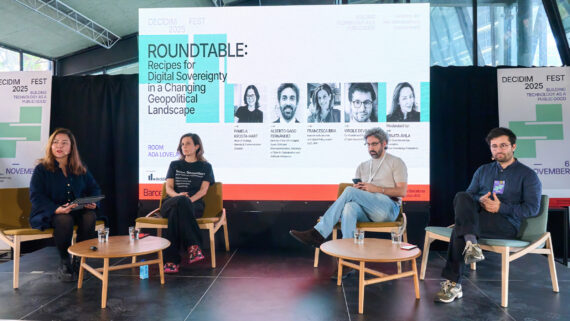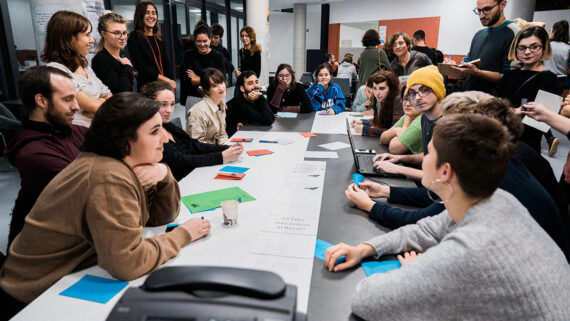The second session of the cycle, “Growing up among screens? Education, technologies, and democracy” brought together experts from various fields to address the challenges and opportunities presented by the digital age for the healthy development of children and adolescents.
New York has taken actions to safeguard the mental health of young people, filing a strong complaint against major social media platforms like TikTok, Instagram, Facebook, Snapchat, and YouTube. A report from the Wheatley Institute at Brigham Young University has warned that young people who spend a significant amount of time in front of screens are twice as likely to suffer from depression.
This complaint, filed in the California Supreme Court, categorizes social networks as “threats to mental health,” thus reinforcing the city’s determination to address this urgent issue. Last February, the Barcelona City Council, echoing this measure, takes a step forward in protecting minors from the threats of social networks by announcing that it will offer legal advice to associations and entities willing to file complaints against social networks.
Against this backdrop, the second session of the “Growing up among screens? Education, technologies, and democracy” cycle explored the transformation of digital consumption habits among young people and highlighted, with the advice of experts, the warning signs of inappropriate use of digital technologies. Additionally, it provided tools and practical advice on how to promote optimal digital health during the growth stage.
Some definitions of digital well-being
At the beginning of the session, each speaker had a minute to define digital well-being from their own perspective, emphasizing the importance of balance, awareness, and control in technology use.
According to Elisenda Noguera Guillamet, Head of the Public Health Service of the Barcelona Provincial Council, “digital well-being is not only about avoiding excessive use but also ensuring that it does not deprive us of a normal and healthy life.” For her part, Elena Flores Márquez, a clinical psychologist at the Addictive Behaviors Unit of the Sant Joan de Déu Hospital in Barcelona, emphasized that “good digital well-being involves minimizing risks and promoting healthy screen use.” Anna Ramis, a teacher and pedagogue, stressed the importance of “being aware of health, control, and enjoyment of the resources offered by digital media, key to leading a healthy digital life.”
Data and trends in digital use among young people in Barcelona with screens
Elisenda Noguera Guillamet presented relevant data on digital consumption habits among young people, based on the results of the Health Habits Survey of students in the fourth year of ESO (first quarter 2023-2024), conducted by the Barcelona Provincial Council since 2015 and with approximately 30,000 responses.
The survey results reveal that 95.4% of the surveyed adolescents, aged between 10 and 15 years, use the internet. According to Noguera, “having access to the internet is normal, as adolescence is a key moment in identity construction and social relationships. Technologies are not harmful; it is inappropriate use that can pose risks.”
The survey by the Barcelona Provincial Council also reveals significant differences in consumption habits between genders. There is an increase in the use of video games and social networks, with 77.6% of girls and 61.9% of boys using them, both on weekdays and weekends. However, boys tend to play more video games (51.1%), while girls make greater use of social networks (77.6%).
Noguera emphasizes the need to promote digital health, teaching young people to navigate digital environments safely and promoting a critical attitude. Additionally, she highlights the importance of offering digital support from all areas: family, education, community, peer groups, and youth organizations.
Warning signs and effects on mental health
Elena Flores Márquez examined warning signs indicating inappropriate or addictive screen use, as well as the negative effects on the mental health of young people. These include changes in entertainment and eating patterns, the predominant establishment of new digital social relationships, neglect of other activities, absences, and low academic performance, as well as an increase in technological dependence and social isolation. It is also essential to pay attention to the type of content they are exposed to, as they may be vulnerable to issues such as self-harm, suicide, cyberbullying, and scams.
A critical aspect, according to Flores, is how this exposure to inappropriate content affects them. “Although there is no direct relationship between violent video games and behavioral changes, young people may perceive this content as real, emphasizing the need for personal intervention.” Abuse of social networks and electronic devices can also be an indicator of deeper mental health issues. “It’s not always the cause, but rather a symptom of other difficulties that young
people may be experiencing,” Flores emphasizes.
Additionally, she stated that it is important not to forget that social networks have also provided health benefits, as they have allowed lonely individuals to find relationships and positive role models. “We need to promote digital health from early stages of life.”
Tips and recommendations for digital and healthy well-being
Anna Ramis reflected on the crucial role of families, educators, and society as a whole in promoting healthy digital development among children and adolescents, sharing practical recommendations to promote adequate balance in technology use from the earliest stages.
One of the most prominent ideas was the three P’s:
— Presence: There is no education without presence. It is essential to establish a direct connection with children and adolescents, both in their digital activities and in their daily interactions.
— Progressivity: Where the devices are located, what schedules are established, who has access, whether they are personal or shared, who has accessibility to the devices. It is important to introduce digital devices progressively into the lives of young people, establishing clear guidelines and adapting them as they mature.
— Permission: It does not consist of allowing everything or prohibiting everything, but in establishing routines and rules, and in seeking healthy digital routines (they exist). It is necessary to promote a flexible attitude, fostering the autonomy of young people in managing their digital lives while establishing clear and healthy limits.
“We need children and adolescents to stop being consumers and start participating in the creation of technology. We need to work with them on the creative side of technology to reflect on it and teach them to generate and produce it,” Ramis affirmed.
The event concluded with an interactive space where the audience could ask questions and share their concerns and experiences. Emphasis was placed on the need for more effective regulation of online content, as well as the importance of fostering critical thinking from the earliest stages of life.







